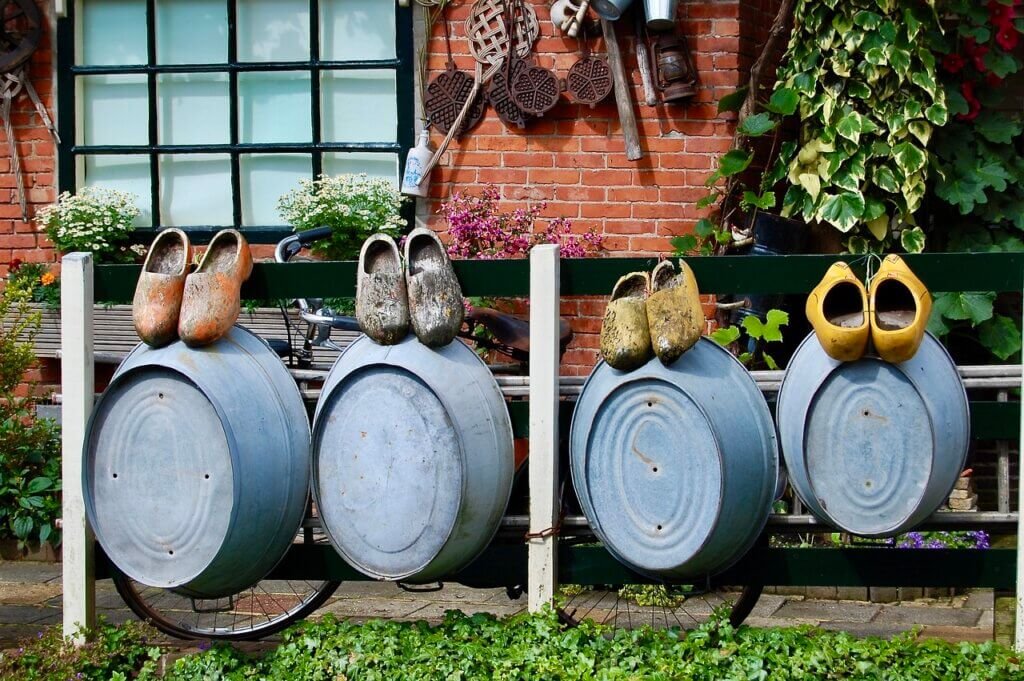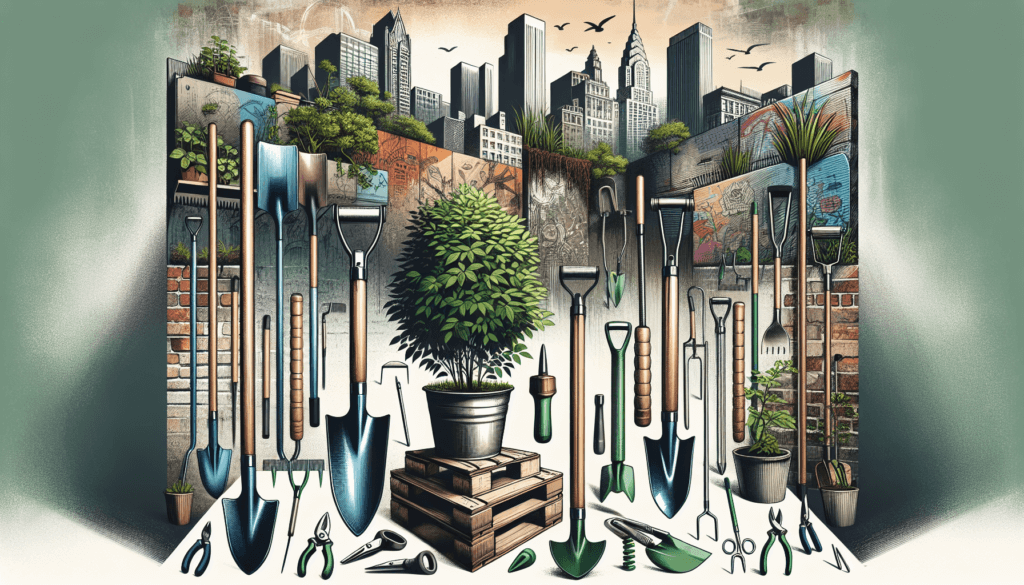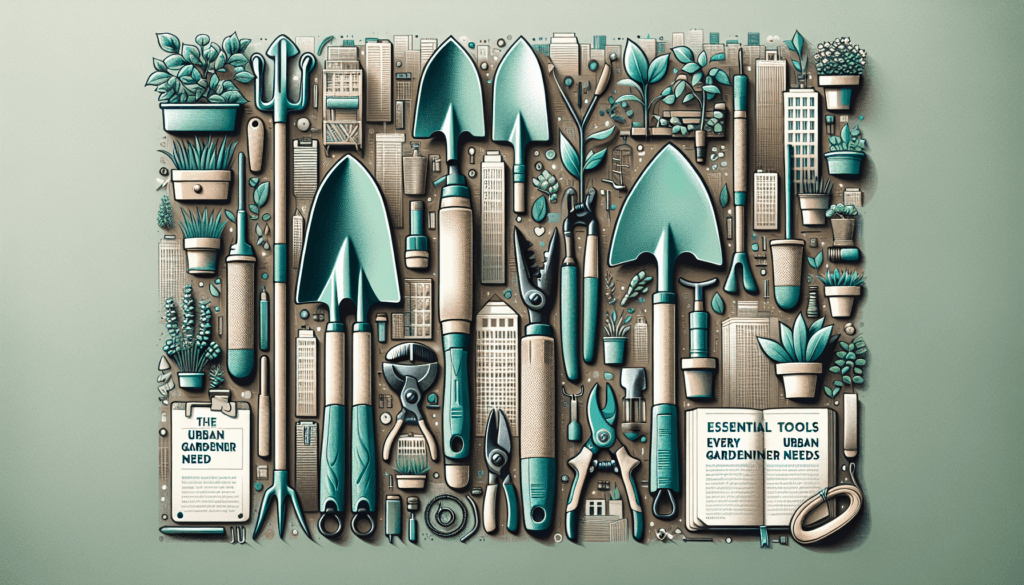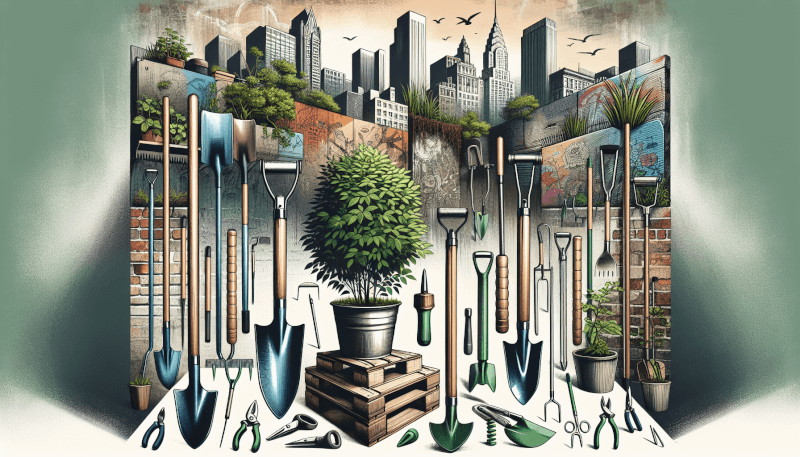Whether you have a small balcony or a backyard garden, being an urban gardener comes with its unique challenges. But fear not, because we’ve got you covered! In this article, we’ll explore the essential tools that every urban gardener needs to tackle the city jungle. From compact watering cans to innovative vertical planters, these tools will not only make your gardening experience more efficient but also help you create a flourishing oasis in the heart of the urban landscape. So grab your trowel and let’s get planting!

Planting Tools
Hand trowel
The hand trowel is a must-have tool for any gardener. It is a small handheld tool that is used for digging small holes, loosening soil, and transplanting plants. Its compact size allows for easy maneuverability, making it perfect for working in tight spaces or container gardens. Whether you are planting flowers, vegetables, or herbs, the hand trowel is essential for getting the job done efficiently and effectively.
Garden fork
The garden fork is a versatile tool that is designed for loosening soil, lifting plants, and turning compost. Its sturdy design consists of several sharp tines that easily penetrate the soil, making it ideal for aerating the ground and breaking up clumps. The garden fork is especially useful when preparing large garden beds or tackling heavy-duty digging tasks. With its strength and durability, the garden fork is a valuable tool in any gardener’s arsenal.
Pruning shears
Pruning shears, also known as secateurs, are essential for maintaining the health and appearance of your plants. They are designed to make precise cuts, allowing you to remove dead or unwanted branches, shape bushes, and prune back overgrown plants. Pruning shears come in various sizes, so it’s important to choose the right one for the task at hand. They are a key tool for promoting healthy growth and maintaining the overall aesthetic of your garden.
Watering Tools
Watering can
A watering can is a classic tool that every gardener needs. It is a simple and efficient way to water your plants, ensuring they receive the right amount of hydration. The spout of the watering can allows for controlled pouring, preventing water from splashing or causing damage to delicate leaves. With its easy-to-use design, the watering can is perfect for indoor and outdoor gardening, providing a gentle and nurturing touch to your plants.
Hose
For larger gardens or outdoor spaces, a hose is a convenient tool for watering plants. It allows for a more extensive reach, making it easier to water plants that are farther away. With adjustable spray settings, you can customize the water flow to suit the needs of different plants. A hose also comes in handy for cleaning garden tools, washing off dirty pots, or even giving your garden a refreshing spray on a hot summer day.
Sprinkler
If you have a large garden or lawn, a sprinkler is an excellent tool for evenly distributing water. It eliminates the need for manually watering individual plants, saving you time and effort. Sprinklers come in various sizes and styles, allowing you to choose one that suits the layout of your garden. With features like adjustable spray patterns and timers, a sprinkler ensures that your garden receives the proper amount of water, promoting healthy and flourishing plants.
Soil Preparation Tools
Gardening gloves
Gardening gloves are an essential tool for protecting your hands while working in the garden. They provide a barrier between your skin and potentially harmful elements such as thorns, sharp branches, or irritating plants. There are different types of gardening gloves available, including waterproof gloves, long-sleeved gloves, and thorn-proof gloves. Choosing the right pair for your needs will ensure your hands stay safe and comfortable while you dig, rake, or handle plants.
Garden rake
A garden rake is an indispensable tool for maintaining your garden’s soil. It is used to level the ground, break up clumps, remove debris, and smooth the surface. The sturdy tines of a garden rake make it effective in preparing the soil for planting, removing rocks or stones, and spreading mulch evenly. Whether you are starting a new garden bed or simply tidying up your existing one, a garden rake is essential for achieving a well-prepared and fertile soil.
Spade
A spade is a versatile tool that every gardener should have in their collection. It is similar to a shovel but with a more narrow and pointed blade, making it perfect for digging holes, transplanting plants, or slicing through tough roots. The sturdy construction of a spade allows for heavy-duty digging tasks, such as removing stubborn weeds or turning over large sections of soil. Investing in a high-quality spade will make your gardening projects easier and more efficient.
Weeding Tools
Hand weeder
A hand weeder is a invaluable tool for tackling pesky weeds in your garden. It is designed to reach deep into the soil and remove weeds by their roots, minimizing the chance of regrowth. With its sharp and narrow tip, a hand weeder easily loosens the soil around the weed, making it easier to uproot without disturbing surrounding plants. Its compact size and ergonomic handle provide comfortable grip and control, allowing you to maintain a weed-free garden effortlessly.
Hoe
A hoe is a versatile tool that serves multiple functions in the garden, including weeding, cultivating, and preparing the soil. With its flat, sharp blade, a hoe can easily slice through weeds or loosen compacted soil. It’s a highly efficient tool when used in a push-pull motion, cutting through weeds directly at the root level. Additionally, a hoe can be used to create furrows for planting seeds or to gently cultivate the soil around existing plants. A hoe is an excellent tool for keeping your garden tidy and free from unwanted vegetation.
Garden scissors
Garden scissors, also known as pruning scissors, are handy tools for trimming and shaping your plants. They are perfect for precision cutting of small branches, leaves, or flowers. Garden scissors have sharp stainless steel blades that provide clean cuts, minimizing damage to the plant. They are lightweight and easy to maneuver, allowing you to access hard-to-reach areas with ease. Garden scissors are a must-have for maintaining the aesthetic appeal of your garden and encouraging healthy plant growth.

Plant Supports
Plant stakes
Plant stakes are essential for providing support to tall or climbing plants. They help prevent plants from toppling over or leaning, ensuring they grow upright and strong. Plant stakes can be made of wood, bamboo, or plastic, and they come in various lengths and thicknesses to suit different plant types. By tying the stems of your plants to the stakes, you can guide their growth and promote proper development. Plant stakes are especially useful for plants like tomatoes, peppers, or flowers that tend to get heavy with fruit or blooms.
Tomato cages
Specifically designed for tomato plants, tomato cages are the go-to support structure for these vining plants. Tomato cages are typically made of wire or metal, forming a cone or cylinder shape. They provide stability and prevent the sprawling growth of tomato plants, keeping them neat and manageable. By keeping the tomato plant upright, tomato cages ensure adequate air circulation and sunlight exposure, leading to healthier plants and better harvests. Tomato cages are a must-have for any gardener growing these popular and rewarding plants.
Trellis
A trellis is a versatile plant support system that can be used for a variety of climbing plants, such as cucumbers, pole beans, or decorative vines. It consists of a framework, usually made of wood or metal, that the plants can latch onto as they grow. Trellises add height and visual interest to your garden while creating optimal growing conditions for vines. By training plants to grow vertically along the trellis, you maximize space and enable better air circulation and sunlight exposure. A trellis is both a practical and decorative addition to any garden.
Gardening Gloves
Waterproof gloves
Waterproof gloves are a useful addition to any gardener’s toolkit, particularly for tasks that involve water, such as watering plants, handling wet soil, or cleaning garden tools. These gloves are typically made from materials like rubber or latex, providing a watertight barrier for your hands. Waterproof gloves keep your hands dry and protected from the elements, ensuring comfort and hygiene during wet gardening tasks. They are a practical investment for any gardener who wants to stay dry and maintain a firm grip in wet conditions.
Long-sleeved gloves
Long-sleeved gloves offer extended protection to your arms while working in the garden. They are designed to cover not only your hands but also your forearms, shielding them from scratches, insect bites, or contact with potentially harmful plants. Long-sleeved gloves are typically made from durable materials like leather or synthetic fabrics, ensuring durability and flexibility. These gloves are a wise choice when dealing with thorny bushes, dense vegetation, or prickly plants found in your garden. Stay safe and comfortable with long-sleeved gloves as you tackle more challenging gardening tasks.
Thorn-proof gloves
For gardeners who frequently deal with thorny plants or prickly shrubs, thorn-proof gloves are a must-have. These gloves are specifically designed to protect your hands and fingers from thorns or sharp objects, reducing the risk of injury. Thorn-proof gloves often feature padded palms, reinforced fingertips, and thick materials such as leather or synthetic fibers. They provide excellent dexterity and grip while keeping your hands safe from potential harm. With thorn-proof gloves, you can confidently handle prickly plants and effectively protect your hands from any thorny encounters.

Pruning Tools
Pruning shears
Pruning shears, also known as secateurs, are indispensable for maintaining the health and shape of your plants. They are designed to make clean cuts, which are crucial for promoting healing and preventing the spread of diseases. Pruning shears have sharp blades that easily slice through small branches, dead stems, or unwanted growth. They come in different sizes, so it’s essential to choose the appropriate pair for the task at hand. Whether you’re shaping shrubs, trimming trees, or removing dead foliage, pruning shears are a vital tool in keeping your garden tidy and vibrant.
Pruning saw
For larger branches or thicker growth, a pruning saw is a powerful tool that provides clean and efficient cuts. Pruning saws have sharp, coarse teeth that make short work of cutting through woody branches. They are ideal for pruning mature trees, removing damaged limbs, or shaping hedges or shrubs. Pruning saws are available in different sizes and styles, including folding saws that offer convenient storage and portability. With a pruning saw in your gardening arsenal, you can tackle more substantial pruning tasks with ease and precision.
Loppers
Loppers are heavy-duty pruning tools that are designed to handle larger branches with ease. They have long handles that provide extended reach, allowing you to access higher or farther branches without the need for a ladder. Loppers typically have sharp blades that make precise cuts, enabling you to remove unwanted growth efficiently. Whether you’re working on fruit trees, thick bushes, or overgrown vines, loppers are the perfect tool for pruning larger, more challenging branches. With their strength and cutting power, loppers make pruning a breeze, helping you maintain the health and beauty of your garden.
Propagation Tools
Seed starting trays
Seed starting trays are an essential tool for propagating plants from seeds. They provide a controlled environment for seed germination, allowing you to start plants indoors before transplanting them outdoors. Seed starting trays usually feature individual cells or compartments where you can plant your seeds. They provide proper drainage, moisture retention, and warmth, creating ideal conditions for successful seedlings. By using seed starting trays, you can give your plants a head start, increase germination rates, and ensure a healthy and thriving garden.
Rooting hormone
Rooting hormone is a valuable aid for plant propagation, particularly for those hard-to-root plants or cuttings. It is a substance, usually in powdered or liquid form, that stimulates root development and enhances root formation. By applying rooting hormone to the base of cuttings, you can increase the chances of successful root growth, leading to robust and healthy plants. Rooting hormone is available in different strengths and formulations, so it’s important to choose the right one for the specific plants you are propagating. With the help of rooting hormone, you can multiply your plant collection and share your favorite plants with others.
Plant labels
Keeping track of different plant varieties or identifying specific plants in your garden is crucial, especially if you’re growing multiple types of plants. Plant labels are simple yet essential tools for labeling and organizing your garden. They can be made from materials such as metal, plastic, or even repurposed materials like popsicle sticks or stones. By using plant labels, you can easily differentiate between different plants, keep track of planting dates, or provide essential information about each plant. Labeling your plants not only adds visual appeal to your garden but also helps you stay organized and maintain accurate records of your plant collection.
Pest Control Tools
Insect netting
Protecting your plants from unwanted pests is a crucial aspect of gardening. Insect netting is a lightweight, mesh-like material that acts as a physical barrier, preventing insects or pests from reaching your plants. The fine mesh of the netting allows sunlight, air, and moisture to pass through, ensuring optimal growing conditions while still protecting your plants. Insect netting can be draped over individual plants or used to cover entire garden beds. With insect netting, you can minimize pest damage without resorting to chemical pesticides, creating a healthy and eco-friendly environment for your plants.
Beneficial insects
Harnessing the power of beneficial insects is a natural and eco-friendly way to control pests in your garden. Ladybugs, lacewings, hoverflies, and praying mantises are just a few examples of beneficial insects that prey on common garden pests like aphids, mites, or caterpillars. By attracting or introducing these beneficial insects to your garden, you can create a balanced ecosystem where pests are kept in check naturally. Planting insect-attracting flowers, providing shelter or water sources, and avoiding chemical pesticides are ways to encourage beneficial insects to thrive in your garden. Embracing these tiny helpers can significantly reduce pest problems, promoting a healthier and more sustainable garden.
Pesticide
While it is always advisable to opt for natural and organic pest control methods, there may be instances where chemical pesticides are necessary as a last resort. Chemical pesticides are designed to eliminate specific pests or diseases that pose a significant threat to your plants. It is crucial to choose the right pesticide for the pest or problem you are facing and to follow the instructions carefully to ensure safe and effective use. When using chemical pesticides, it’s important to exercise caution, minimize their impact on beneficial insects or the environment, and always prioritize the health and well-being of your plants.
Storage Solutions
Garden shed
A garden shed is a practical storage solution for all your gardening tools, equipment, and supplies. It provides a designated space to keep everything organized and protected from the elements. Garden sheds come in various sizes and designs, allowing you to choose one that suits your space and storage needs. With shelves, hooks, and compartments, a garden shed helps you maintain a clutter-free garden while ensuring that your tools and supplies are easily accessible when you need them. Investing in a garden shed is a long-term storage solution that adds convenience and functionality to your gardening endeavors.
Tool organizer
Keeping your gardening tools organized and easily accessible is essential for efficient and enjoyable gardening. A tool organizer, such as a wall-mounted rack or a tool shed organizer, helps you store and arrange your tools neatly. It ensures that your tools are in good condition, prevents damage or rusting, and saves you time from searching through a jumble of tools. Tool organizers come in various sizes and designs, offering compartments, hooks, and slots to accommodate different types of tools. By implementing a tool organizer in your gardening routine, you can streamline your tasks and enhance your gardening experience.
Storage containers
Storage containers are an excellent way to keep smaller gardening supplies, such as seeds, fertilizers, or gardening gloves, neatly organized and protected from moisture or pests. They come in various sizes, materials, and styles, allowing you to choose the right containers for different items. Plastic or metal containers with tight-fitting lids are ideal for storing seeds or organic fertilizers, preventing moisture or pest damage. Transparent containers make it easy to locate items at a glance, while stackable containers maximize space efficiency. With storage containers, you can create a clutter-free garden shed or storage area, ensuring that everything you need is easily accessible and well-preserved.
In conclusion, having the right tools is essential to ensure successful and enjoyable gardening. From planting tools to pest control solutions and storage solutions, each tool serves a specific purpose and contributes to the overall health and productivity of your garden. By investing in high-quality tools and caring for them properly, you can create a thriving urban garden that brings joy and beauty to your surroundings. So gather your gardening gloves, grab your favorite tool, and embark on your gardening journey with confidence and enthusiasm. Happy gardening!


